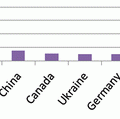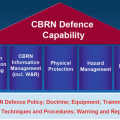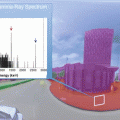Fig. 6.1
Demographics for the nuclear security: the nexus between policy and technology course. The number of technical, nontechnical, and “virtual” participants in the course is listed per academic year
The course curriculum addresses historical and current events, and features in-depth case studies that highlight today’s most pressing security concerns. Lecture topics vary by year as the instructors reach to address current security issues, such as the North Korean nuclear threat, the Iranian nuclear program, and interdicted nuclear material. The instructors employ a dual-track teaching method to minimize knowledge gaps between the social scientists and technical students. For the first half of each course meeting, social scientists and humanities students are trained in fundamental nuclear physics and scientific applications in radiation detection, nuclear reactors and weapons design, and more. Contemporaneously, students from technical science and engineering fields are taught the fundamentals of international relations, government, and public policy. The second half of the course meeting brings all students together in one room to hear a joint-lecture on a topic in nuclear security, drawing on concepts and lessons from both sessions in the first half of the course meeting. By separating students by background, the instructors are able to minimize knowledge gaps and level the playing field for all students, who can then engage with peers from radically different fields and backgrounds on the subject of nuclear security.
The students are given opportunities to practically apply material covered in lecture and discussion through a mid-semester crisis simulation and a semester-long research project. The crisis simulation, conducted in two phases, enables students to sit in the seats of powerful decision-makers in the US government, such as the President or the Chairman of the Joint Chiefs of Staff, and work collaboratively under time pressure to address a mock crisis situation. For example, the Spring 2014 crisis simulation provided the following scenario:
It is late May 2014. The situation in Ukraine has worsened substantially, and parts of eastern Ukraine are now in civil conflict between pro-Ukrainian and pro-Russian forces. President Obama has imposed sectoral sanctions against the Russian oil and natural gas, banking, and technology sectors. In response, President Putin has stipulated that Russia is advising Iran not to follow through on the terms of the interim agreement. A special P5+1 negotiating session with Iran is scheduled for late May to determine whether the interim agreement can in fact be converted into a permanent treaty that would halt or roll back Iran’s nuclear weapons program.
—Spring 2014
The first phase of the simulation exercise was a US-Israel negotiation on how to approach the Iran nuclear discussions; the second phase involved a US-Iran negotiation simulating the negotiations currently in progress [5]. The students were assigned roles as US government representatives, Israeli government representatives, and Iranian government officials. Following the US-Israel discussions that highlighted major differences between the two governments, the US-Iran negotiations were more extensive and led to possible compromises in future rounds. Students delivered options for negotiating a deal with Iran, as well as formulating a response to Russia in the wake of the Ukraine conflict. The students had to work under time pressure and overcome communication challenges to fully understand available policy options informed by technical information about Iran’s nuclear program.
The semester-long collaborative research project provides students with another opportunity to practically apply lessons learned, and challenges students to overcome communication barriers across the technical and nontechnical fields in order to develop an informed policy recommendation built on a clear understanding of the nuclear science and technological issues. Hypothetical project topics are also drawn from current events, and all enrolled students must work together to coordinate a coherent response. For example, the Spring 2014 topic tasked students with preparing a paper outlining how the US should proceed in the event of a nuclear attack on Moscow by Chechen rebels. The instructors required students to consider available technical and intelligence information, and technical pathways that could be pursued to fill information gaps and help establish that the US was not involved. Though the instructors provided guidance and support throughout the semester, students had to work collaboratively and independently to overcome communication challenges across academic cultures and effectively organize into sub-topic groups to explore specific components of the project. The project stimulates close interaction across diverse disciplines and also promotes the development of valuable professional skills in project management, communication, and leadership.
The Nuclear Security course also features a distance-learning component, which enables students from other NSSC academic institutions to engage in the course. Initially, course lectures were available as recordings and distributed to affiliated NSSC faculty and students. In Spring 2014, the course was made broadly available through a live-streaming webcast. As a result, 11 virtual auditors from NSSC partner institutions participated in the course in real time (see Fig. 6.1). Through the distance-learning and archiving platform, the NSSC has engaged a broader cross section of students at partner academic institutions while ensuring that course lessons will be available for years to come.
Retention of social scientists and humanities students remains a challenge for the course. The instructors have noted that technical jargon, equations, and graphs intimidate nontechnical students who are not confident about overcoming a steep learning curve to understand fundamental nuclear science. In order to recruit and retain more nontechnical students, a Nuclear Science for Future Policymakers workshop was fielded in January 2015. The workshop focused on the relationship between science and policy, and featured lectures on fundamentals of radiation and radioactivity, the nuclear fuel cycle, and nuclear weapons design. A radiation detection practical activity provided nontechnical students with valuable hands-on experience.
6.3 Nuclear Security Policy Research
In contrast to research projects facilitated under formalized programs such as the Undergraduate Research Apprenticeship Program [6] or other narrowly defined research assistantships on campus, the Nuclear Policy Working Group (NPWG) provides a unique forum in which students develop their own interdisciplinary research projects in nuclear security policy [7]. The NSSC Director of Education, Dr. Bethany Goldblum, founded the NPWG in Fall 2012 to educate students on important issues in nuclear security, foster close and continuing collaboration between students from diverse academic disciplines, and guide the development of student-led research projects and policy recommendations to contribute to the field of nuclear security. This low-cost, high-impact working group model is driven by student passion; the majority of the two-dozen active members of the NPWG are not paid and do not receive course credit for their participation in weekly seminars and collaborative research. The working group provides an environment in which undergraduate students can interact with and engage in collaborative research projects with graduate students, postdoctoral scholars, national laboratory scientists and researchers from a variety of nontechnical and technical fields.
The NPWG holds weekly interactive seminars, during which students explore topics in nuclear security policy, such as nuclear forensics, arms control, societal verification, and network science for nonproliferation. Guest speakers from the national laboratories, think tanks, other academic institutions and campus research centers provide expert guidance via lecture and discussion. The working group forum encourages freethinking and creative solutions to today’s most challenging issues in nuclear security. In many high-level academic and national laboratory settings, students may be intimidated by the expertise of their research groups and potential criticisms from their peers to ask questions. The NPWG creates an environment in which there is no unreasonable question, and such a relaxed, supportive atmosphere enables students to explore basic questions, such as “What is fission?” and “What is the Non–Proliferation Treaty?” To further understanding of more complex concepts, such as radiation detection and international security policy, the NPWG also offers introductory workshops to supplement expert lecture and discussion.
Stay updated, free articles. Join our Telegram channel

Full access? Get Clinical Tree






